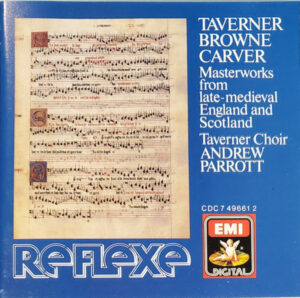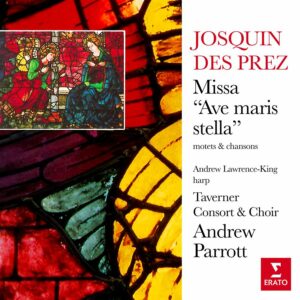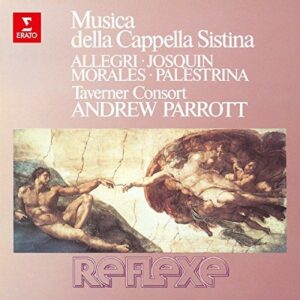Program: #23-34 Air Date: Aug 21, 2023
To listen to this show, you must first LOG IN. If you have already logged in, but you are still seeing this message, please SUBSCRIBE or UPGRADE your subscriber level today.
There are few major figures in the field we have not had as a guest in our program’s history; one of these is the great Andrew Parrott with his Taverner Consort. This week, music of Taverner, Josquin, and Palestrina.
NOTE: All of the music on this program comes from the ensemble the Taverner Choir directed by our guest Andrew Parrott. For complete information about this ensemble: www.taverner.org.
I. Taverner, Browne, Carver: Masterworks from late-medieval England and Scotland. EMI CD CDC 7 49661-2.

From Amazon: There's something of Stonehenge about English polyphony - windswept, grand and lonely - of the 15th Century. Not that it's rude or primitive! On the contrary, it's remarkably sophisticated and quite independent of continental practice. The French and Burgundian composers of the same era heard the difference, and called it the English Countenance, a harmony based on mean tuning, perfect thirds, parallel movement, and avoidance of tonic cadences.
One has to wonder how the howling Picts and naked Britons painted with blue woad evolved in a mere 2000 years into the ruddy Eton College choir boys - manly chaps though a trifle epicene - who have maintained the British choral tradition fron the Middle Ages to the present day.
Eton College in the 15th Century maintained one of the largest and most highly skilled choirs, for the singing of the daily liturgical offices, to be heard anywhere in Christendom. That choir has left us its Choirbook, one of the greatest cultural treasures of the United Kingdom; most of the music on this CD comes from that manuscript, a page of which is reproduced on the cover of the text booklet. The notes for this performance are exceptionally ample, by the way, almost an Eton College lecture worth of historical information. John Browne is the composer most represented in the Choirbook; he was a 'scholar' of Eton and perhaps the compiler of the manuscript. Little more is known about him, and even less is known about the Scottish composer Robert Carver. His surviving music, however, was most likely prepared for the large choir of the Scottish Chapel Royal. John Taverner, a generation younger, also wrote for a large established choir, that of Cardinal College, now Christ Church Oxford, under the patronage of Cardinal Wolsey.
The presence of such massive choral forces certainly influenced the style and structure of this music. Andrew Parrot's Taverner Choir is exactly suited to perform the six polyphonic masterworks on this CD. Thirty four singers participated in the recording, with the largest number of them on track 6, Taverner's O Splendor Gloriae. Such choral forces are hard to record, but EMI did wonders with this session in 1989. The choristers actually sound like human voices! Of course, their precision of diction and articulation deserve much of the credit. Parrot uses women singers on the soprano lines, but the women included have all the 'white voice' purity of choir boys.
- O Maria salvatoris mater : a 8 / John Browne (13:43)
- Quemadmodum : a 6 / John Taverner (5:22)
- O bone Jesu : a 19 (11:08)/ Robert Carver
- Gaude flore virginali : a 5 (10:05) / Robert Carver
- Stabat Mater dolorosa : a 6 / John Browne (14:38)
- O splendor gloriae : a 5 / John Taverner (10:18)
II. Josquin des Prez. EMI CD CDC 7 54659 2.

From BBC Music: Josquin’s reputation was so great – he was described two centuries after his death as ‘a talent of whom fame speaks – and will speak for ever’ – that his music has seemed Olympian and remote. This disc reveals other facets, witty, worldly, enigmatic. Secular and sacred texts are wickedly juxtaposed; another text forms an acrostic on his name and a coded reference to his birthplace.
There’s some fascinating number symbolism too – but you must read the accompanying booklet for yourself…Josquin’s transparent word-setting, often reducing the texture to pairs of duetting voices, is heightened by a solo ensemble singing the motets and chansons, tuning beautifully to each other. But the pitch centre wanders, so little that it would be quite imperceptible were it not hauled crudely back again, presumably at an editing break.
The colours are imaginatively varied: the harp plays three chansons, with some subtle balancing of the original vocal lines; then the Mass on the plainchant ‘Ave Maris stella’ is sung by the full Taverner Choir, a foil to the solo voices which open and close the disc. Warmly recommended as a vignette of the many sides to Josquin.... George Pratt
- Illibata Dei virgo nutrix, 7:40
- Adieu mes amours, 2:36
- Plaine de dueil, 5:09
- Je n'ose plus, 1:51
- Que vous madame, 5:10
- In te Domine speravi, 2:28
- Regretz sans fin, 6:41
- Ave maris stella (Anonymous - Donald Greig, Stephen Charlesworth, Allan Parkes, Christopher Foster, Francis Steele, Jeremy White, John Milne, Andrew Parrott, Deryck Webb, Harvey Brough, Leigh Nixon, Paul Badley, Paul Tindall, Peter Long, Rodrigo del Pozo & Simon Berridge), 4:01
- Missa "Ave maris stella": Kyrie, 2:38
- Missa "Ave maris stella": Gloria, 4:58
- Letabundus, 3:28
- Missa "Ave maris stella": Credo, 6:44
- Missa "Ave maris stella": Sanctus, 4:37
- Missa "Ave maris stella": Benedictus, 2:47
- Missa "Ave maris stella": Agnus Dei, 4:20
- Gaude Virgo, Mater Christi, 3:26
- Salve regina, Josquin Des Prez - Andrew Parrott & Taverner Consort, 7:44
III. Music of the Sistine Chapel. EMI CD CDC 7 47699 2.

From Gramophone: During the second half of the fifteenth century the papal choir was established in what was to remain its final form for the next couple of centuries by Sixtus IV, the founder of the Sistine Chapel. Until its decline in the eighteenth century, this celebrated musical foundation, which served as a model for countless other institutions throughout Catholic Europe, employed a steady stream of eminent singers and composers, including Dufay, Josquin, Morales and Palestrina. Much of their music was written for the Sistine Chapel, and a large series of surviving choirbooks in the Vatican Library offers a detailed insight into what the choir sang, and the way in which older repertory continued to be performed much later than it would elsewhere. In addition, ceremonial books and other contemporary documents provide a great deal of information about when and how polyphony was incorporated into the liturgy. If there was ever a case for well-founded historical reconstruction of sixteenth-century music, then the Sistine Chapel repertory is surely it.
In many ways, the Taverner Consort and their director Andrew Parrott are well-equipped for the task. Parrott has always shown himself to be alive to the historical issues of early-music performance, and able to provide thoughtful and sometimes controversial answers to interpretational difficulties. His records always provide a surprise, and this one is no exception. The centrepiece is not (as might be thought from the advertised contents of the record) Allegri's famousMiserere but rather a compound version of that work in which successive verses are taken from differently arranged and ornamented versions that have survived among the Sistine manuscripts. The result is not a piece that was ever performed, but an intriguing historical hybrid, delivered with an appropriately bright and at times even slightly hard sound. There seems to be a conscious effort here to achieve an Italianate effect, and it is very effective particularly in the upper lines which possess a firm and rich tone close (one imagines) to the sound that the falsettists who sang this part in the sixteenth century might have achieved.
Yet despite the imagination and care with which this record has been planned and executed (the decision to add embellishment to pieces other than the Allegri might be singled out as an example of Parrott's attention to historical detail), there remains a striking curiosity. Sixtus IV established the choir at a membership of 24 singers, and in the course of the next century the numbers rose. But the Taverner Consort perform all the pieces on this record with only one voice to a part. Certainly much of this music (though not the Allegri) would have been performed in this way in Brescia or Bergamo, but the one place it would not have been done with such small forces was the Sistine Chapel.
For a record which wears its academic credentials so conspicuously, and on the whole successfully, this is an extraordinary decision for which neither the generous acoustic nor the sensitive efforts of the engineers can compensate.'
- Stabat mater, Giovanni Pierluigi da Palestrina, 11:03
- Liber primus motettorum: No. 8, O beata et benedicta et gloriosa Trinitas Giovanni Pierluigi da Palestrina, 7:27
- Miserere, Gregorio Allegri, 13:21
- Motettorum liber tertius: No. 33, Jubilate Deo, Giovanni Pierluigi da Palestrina, 4:11
- Lamentabatur Jacob, Cristobal de Morales, 10:30
- Liber primus motettorum: No. 24, Dum complerentur dies Pentecostes Giovanni Pierluigi da Palestrina, 5:49
- Pater noster, Josquin Des Prez - Andrew Parrott & Taverner Consort, 8:36
Composer Info
John Browne, John Taverner, Robert Carver, Josquin des Prez, Giovanni Pierluigi da Palestrina, Gregorio Allegri,Cristobal de Morales.
CD Info
EMI CD CDC 7 49661-2, EMI CD CDC 7 54659 2, EMI CD CDC 7 47699 2